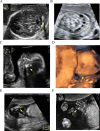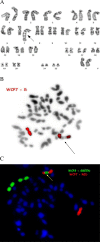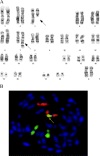Prenatal identification of partial 3q duplication syndrome
- PMID: 31196198
- PMCID: PMC6567560
- DOI: 10.1186/s12920-019-0547-y
Prenatal identification of partial 3q duplication syndrome
Abstract
Background: The 3q duplication syndrome is a result of duplication of a large fragment of the long arm of chromosome 3, mainly 3q21-qter, and in most cases it is diagnosed only after birth. The phenotypic consequences resulting from genetic imbalance are an important source of information for genetic counselling, especially in prenatal diagnostics. However, in most cases it is impossible to define them precisely because the final clinical presentation is a result of an overlap, usually due to different sizes of deletions and/or duplications not only chromosome 3 but also of translocation partner chromosome. In this article, we present a prenatal diagnosis of the 3q duplication syndrome in a foetus, arising from a balanced insertion ins (7,3)(q21.2;q12.3q29) carried by the mother.
Case presentation: The article presents a case of a 29-year-old woman referred to the Genetic Outpatient Clinic for consultation in the 12th week of her fifth pregnancy with a diagnosis of generalised hydrops foetalis. The analysis of karyotype using GTG technique and FISH allowed diagnosis of a balanced aberration in the mother, and determined the type of chromosomal rearrangement, which allowed the identification of the origin of the additional genetic material in the foetus and the previous malformed child of the same couple. The use of molecular karyotyping techniques (FISH and aCGH) allowed a precise determination of the size of the imbalanced fragments in the affected siblings.
Conclusions: The aCGH technique is particularly valuable for the diagnostics of submicroscopic deletions and duplications, if no imbalanced chromosomal aberrations are detected by routine cytogenetic tests. It is also a valuable technique for identifying and fully characterizing genetic material of unknown origin, which can't be identified using routine cytogenetic techniqes. However, it does not allow identification of balanced aberrations in carriers.
Keywords: 3q duplication; Genetic syndrome; Prenatal diagnosis; Ultrasounds.
Conflict of interest statement
The authors declare that they have no competing interests.
Figures




Similar articles
-
New insights on partial trisomy 3q syndrome: de novo 3q27.1-q29 duplication in a newborn with pre and postnatal overgrowth and assisted reproductive conception.Ital J Pediatr. 2023 Feb 9;49(1):17. doi: 10.1186/s13052-023-01421-y. Ital J Pediatr. 2023. PMID: 36759911 Free PMC article.
-
[Prenatal diagnosis of a fetus with 1p36 deletion syndrome and 3p26.3p25.2 duplication].Zhonghua Yi Xue Yi Chuan Xue Za Zhi. 2024 May 10;41(5):617-621. doi: 10.3760/cma.j.cn511374-20230814-00064. Zhonghua Yi Xue Yi Chuan Xue Za Zhi. 2024. PMID: 38684312 Chinese.
-
[PRENATAL DIAGNOSIS OF FOETAL TRISOMY 3Q WITH PATERNAL ORIGIN].Akush Ginekol (Sofiia). 2015;54(3):43-7. Akush Ginekol (Sofiia). 2015. PMID: 26137780 Bulgarian.
-
Non-invasive prenatal testing for fetal chromosomal abnormalities by low-coverage whole-genome sequencing of maternal plasma DNA: review of 1982 consecutive cases in a single center.Ultrasound Obstet Gynecol. 2014 Mar;43(3):254-64. doi: 10.1002/uog.13277. Epub 2014 Feb 10. Ultrasound Obstet Gynecol. 2014. PMID: 24339153 Review.
-
Prenatal findings and molecular cytogenetic analyses of partial trisomy 12q (12q24.32-->qter) and partial monosomy 21q (21q22.2-->qter).Prenat Diagn. 2006 Apr;26(4):313-20. doi: 10.1002/pd.1399. Prenat Diagn. 2006. PMID: 16506269 Review.
Cited by
-
New insights on partial trisomy 3q syndrome: de novo 3q27.1-q29 duplication in a newborn with pre and postnatal overgrowth and assisted reproductive conception.Ital J Pediatr. 2023 Feb 9;49(1):17. doi: 10.1186/s13052-023-01421-y. Ital J Pediatr. 2023. PMID: 36759911 Free PMC article.
-
Inherited unbalanced reciprocal translocation with 3q duplication and 5p deletion in a foetus revealed by cell-free foetal DNA (cffDNA) testing: a case report.Eur J Med Res. 2021 Jun 29;26(1):64. doi: 10.1186/s40001-021-00535-5. Eur J Med Res. 2021. PMID: 34187576 Free PMC article.
References
-
- Abreu-Gonzalez M, Garcia-Delgado C, Cervantes A, Aparicio-Onofre A, Guevara-Yanez R, Sanchez-Urbina R, Gallegos-Arreola MP, Luna-Angulo A, Estrada FJ, Moran-Barroso VF. Clinical, cytogenetic, and biochemical analyses of a family with a t(3;13)(q26.2;p11.2): further delineation of 3q duplication syndrome. Case Rep Genet. 2013;895259:1–8. - PMC - PubMed
-
- Holinski-Feder E, Reyniers E, Uhrig S, Golla A, Wauters J, Kroisel P, Bossuyt P, Rost I, Jedele K, Zierler H, Schwab S, Wildenauer D, Speicher MR, Willems PJ, Meitinger T, Kooy RF. Familial mental retardation syndrome ATR-16 due to an inherited cryptic subtelomeric translocation, t(3;16)(q29;p13.3) Am J Hum Genet. 2000;66:16–25. doi: 10.1086/302703. - DOI - PMC - PubMed
Publication types
MeSH terms
Supplementary concepts
LinkOut - more resources
Full Text Sources
Medical

